Epileptic. Later, mental, mental handicapped
The third of the Epsom cluster to be built, the Ewell Epileptic Colony, lying partly in the parish of Ewell, was officially opened in 1903 by the Duke of Fife, the Lord-Lieutenant of the County of London, accompanied by Princess Louise, the Duchess of Fife.
The first epileptic institution to be set up by the LCC and supported by the rates, it owed its existence to the fact that the Asylums Committee of the LCC considered that epileptic patients with a mild form of the disease already housed in its asylums would benefit from colony or farm life.
Built on the northeast part of the Horton estate for £98,000 (a total cost per bed of £300), the Colony could accommodate 326 patients, 60 of whom were female. A public road - Hook Road - separated the Colony from the rest of the estate. Twenty acres of the 112 acre site contained the buildings, built on the most elevated part, some 200 feet above sea level.
The 'dispersed colony' format, with villas widely spaced around the site, avoided the long corridor effect of other asylums. The administration block contained offices and staff accommodation, as well as a female admission ward for 32 patients. It was joined by a long corridor to other buildings containing storerooms, the kitchen and a large hall. The hall was used by patients for dining and recreation (it had a stage built at one end, for entertainments) and also served as a chapel. Those physically able were expected to assemble for dinner in the hall, but other meals were taken in their wards. The boiler house, workshops and water tower were located between the stores and the female admission ward. The laundry was opposite the boiler house. Because of the small size of the institution, it did not have a mortuary and presumably used the facilities of one of the larger hospitals nearby.
The patients were accommodated in 8 one-storey villas to the east of the administration block. The villas faced southeast and were designed in the Queen Anne Revival style. They were named after trees - Holly, Lime, Pine, Elm, Chestnut, Hawthorn, Walnut and Beech - and were widely spaced around the site. Four were built in deep red brick with artificial stone dressing (as was the administration block), while the stores and remaining four villas were faced with rough stone. The roads linking the villas enclosed a space which was used as a cricket pitch and sports ground. Each villa housed 38 patients and was staffed by a resident married couple. Verandahs and spreading porches enabled patients to have access to the open air in all weathers. All the buildings were lit by electricity, had electric fire alarms, and were connected by a telephone system.
The Colony was expected to be self-sufficient, with the patients providing the labour force. They worked on the farm, in the kitchens and laundry, and in the grounds. In the workshops they manufactured simple products, such as wire brushes.
In 1909 two more villas were added to the site, and the number of patients increased to 429.
In 1918, following WW1, the site became the Ewell War Hospital, administered by the Ministry of Pensions. It treated neurasthenic ex-servicemen until 1927 when it was returned to the LCC for use as a mental hospital. It was renamed the Ewell Mental Hospital.
The Mental Treatment Act, 1930, enabled for the first time admission of voluntary patients to public mental hospitals. The LCC made special accommodation available at the Hospital for patients with illness of recent onset to be admitted on a voluntary or temporary basis, following attendance at Out-Patients Departments of various London teaching hospitals.
In 1935 plans were made to extend the Hospital in two stages. The first extensions were completed in 1936, increasing the number of beds to 528, and the second in 1938. It then had 933 beds. Medical students attended on rotation from the London teaching hospitals, while consultant staff from the Hospital held Out-Patient clinics in London. The separated accommodation in the villa system for different categories of mentally ill patients encouraged those with illness of recent onset to seek early admission and treatment (previously the fear of being associated with the chronic mentally ill had made patients reluctant to be admitted to a mental hospital). A large number benefitted from early treatment. The Hospital also established a good working relationship with Wandsworth Prison, treating prisoners when necessary. Patients were allowed to stay for a maximum of two years before being transferred elsewhere.
In 1938 it was renamed St Ebba's Hospital.
In 1948 the Hospital joined the NHS as part of the South West Metropolitan Regional Board, under the administration of the St Ebba's and Belmont Hospital Management Committee. It had 738 beds. Unlike its sister hospitals in the Epsom cluster, patients continued to be referred from all the London Metropolitan Regions, with the exception of the North West.
In 1949 an Adolescent Unit was established for patients aged between 12-17 years (there was also one at Bethlem Hospital). The majority of patients came from London, mostly voluntarily under the signature of their parents. Treatment took three forms - psychological, occupational and educational. Insulin coma treatment proved to be less successful in these young patients, compared with in adults, probably because the parents were often the chief cause of the juvenile's breakdown. Schooling continued for these patients, with teachers provided by the Surrey Education Authority.
By this time, some 95-97% of St Ebba's patients were voluntary, the rest being under temporary certificate, with a few certified under the 1890 Act. A Psychological Department had opened and an Occupational Therapy Department offered diversion for the patients. Handicrafts were practised in the wards by those physically ill, on insulin treatment or too mentally disturbed to leave the ward unsupervised. Patients also worked in the laundry, the needleroom, the tailor's, bootmaker's and other workshops, but their occupational backgrounds had changed. No longer unskilled paupers used to manual labour, patients tended to be educated with clerical jobs. With fewer chronic patients, the workshops declined as the potential workforce chose educational or cultural activities instead. They attended discussion groups, as well as classes in music appreciation, art, drama, dancing and dress-making. Patients produced plays, and made use of their Social Club, playing billiards and darts or watching TV. They also published a weekly bulletin, called 'Trees'. When the NHS had first commenced, voluntary effort of any kind to help a hospital and its patients was very restricted and even precluded, but as the years went by, not only was it permitted, but even encouraged.
In 1950 an Electroencephalography Department opened.
In 1961, the Medical Research Council (MRC) appointed a consultant at St Ebba's, jointly with its Neuropsychiatric Unit at Queen Mary's Hospital in Carshalton, to research the endocrinological aspects of psychoses.
In 1962, when the Hospital had 865 beds for psychiatric patients, the South West Metropolitan Regional Board changed its use to a hospital for mentally subnormal patients. This change came into effect in February, and psychiatric patients ceased to be admitted in March. The St Ebba's and Belmont Hospital Management Hospital Committee was dissolved. Belmont Hospital joined the St Helier Group with the Henderson Hospital and St Ebba's Hospital joined the Fountain and Carshalton Group, based at Queen Mary's Hospital.
Most of the psychiatric patients in residence were sent to hospitals nearer their homes and the wards were adapted for the reception of the new patients, who would be transferred from the Fountain Hospital, then in the stages of closing. St Ebba's Hospital then had 470 beds - 183 for the mentally ill and 287 for the mentally retarded. The Fountain Hospital closed at the end of March 1963, when 300 patients had to be moved; 258 were accommodated in 13 wards converted for the purpose at St Ebba's. Children aged from 13 to 16 years were transferred to Queen Mary's Hospital. As they got older, they were sent to St Ebba's. Later the remaining psychiatric patients were transferred to other hospitals. The Adolescent Unit moved to Long Grove Hospital and the MRC Unit to West Park Hospital.
In 1969 an Industrial Training Unit opened in Hawthorn, one of the villas, and provided training in skills and handicrafts for 200 patients, according to their degrees of handicap.
In 1971 the Cement Products Department opened, making paving slabs in a variety of sizes and colour. Financed by the King's Fund, it provided an additional area of work for patients. At this time the Hospital had 611 beds.
Following the NHS reorganisation in 1974 the Hospital, along with the others in the Fountain and Carshalton Group, was included in the St Helier Hospital and Queen Mary's Hospital District, under the auspices of the Merton, Sutton and Wandsworth Area Health Authority (AHA). With the exception of Queen Mary's Hospital, all the other units were outside the geographical area covered by the District and therefore were managed on an extra-territorial basis. By 1979 St Ebba's Hospital had 629 beds, the largest hospital for the mentally handicapped in the District.
In 1982 the Merton, Sutton and Wandsworth AHA became the Merton and Sutton Health Authority. St Ebba's Hospital was included in the new division, but also received patients from the Richmond, Twickenham and Roehampton and Wandsworth Health Authorities.
In 1987 a Parents and Relatives Group (PARG) was formed to campaign for the retention of the site as a special village community for people with learning disabilities. The residents would be able to live in small homely buildings and would have all the facilities they need on site.
By 1995 the Hospital had 484 beds and the patients continued to be rehoused in community homes.
In 2003 PARG launched a final campaign to save St Ebba's, but this did not succeed. The following year work began to convert and upgrade some of the old buildings for 55 long-stay patients on 10 acres of the site.
The main gate is quarded and trespassers are warned, but the fencing is often gappy. South Lodge, a mental health centre for juveniles, is located in the southwest corner. The Hospital is now run by the Surrey and Borders Partnership NHS FoundationTrust.
In 2008 Oasis, a new purpose-built Therapy Suite and Hydrotherapy Pool, was opened by the Mayor of Epsom and Ewell.
The Hospital remains officially open, although most of its services have closed or been relocated.
Present status (March 2008)
The remainder of the site was sold to English Partnerships. In 2007 one of the derelict villas was set alight by arsonists.
St Ebba's farm is now used by Epsom Riding for the Disabled.
Plans are being made for most of the 40-acre site to be redeveloped along with the West Park Hospital. It is planned to build 322 eco-homes, varying from one bedroom-flats to 5-bedroom houses. The former administration building will remain, as will the water tower and Lime Villa, both of which are listed. Walnut Villa is also incorporated in the scheme.
Demolition of the rest of the old derelict wards will begin in October 2008.
UPDATE (July 2010)
The site is now known as Parkviews. The fencing has been repaired and new housing is being built along the southeast side by the footpath.
South Lodge is still active, as well as the clinic on the northwest corner.
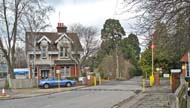
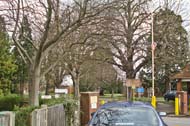
The porter's lodge and main gate of the Hospital.

One of the refurbished villas still in use.
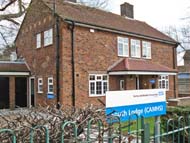
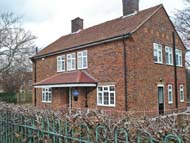
South Lodge, the juvenile mental health unit.
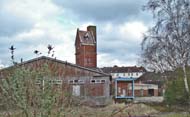
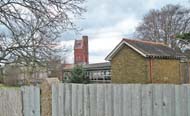
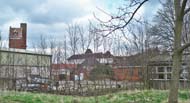
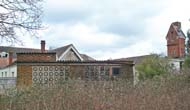
The water tower and other buildings seen from Hook Road.
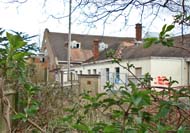
Buildings further along Hook Road.


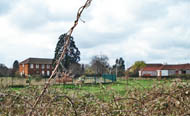
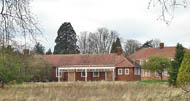
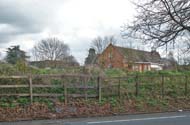
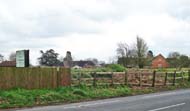
St Ebba's farm, now a riding school for the disabled, on the west side of the site.
UPDATE (July 2010)
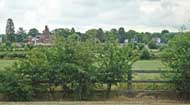
The St Ebba's Hospital site, as seen from Horton Lane.
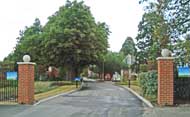
The main entrance to Parkviews.
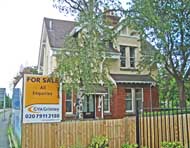
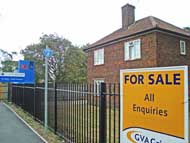
Buildings near the main gate for sale.

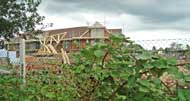
New housing being built on the southeast side of the site.
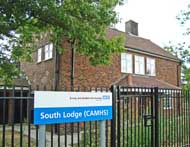
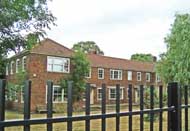
South Lodge, (left) and another building in use (right). Surrey and Borders Partnership NHS Foundation Trust have five purpose-built residential centres for people with learning disabilities on the St Ebba's Hospital site. Two other centres provide therapeutic daytime activities.
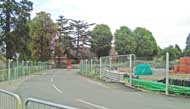
The Oasis Therapy Suite at the northwest of the site.
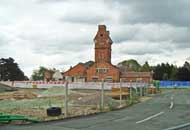
The water tower is marooned in the middle of the building site. Most, if not all, of the chalets have now been demolished.
The name of Epsom is derived from Ebba's Ham (Ebba was a Saxon landowner).
Legend has it that St Ebba
was Abbess of Coldingham,
once the largest monastery in
Scotland. In 870, during an incursion by the Danish pirates
Hinguar and Hubba, the Abbess was concerned to preserve her virginity.
She gathered the nuns in the Chapter house and, following a
moving discourse, cut off her nose and upper lip with a blade.
The
nuns did likewise. Faced with the sight of this horror, the
pirates set fire to the monastery and St Ebba and the nuns died virgo intacto.
Rollin H 2003 One hundred years ago. Epileptic colony, Ewell, Surrey. British Journal of Psychiatry 183, 174-175.
Rollin H 2005 One hundred years ago. Asylum reports. British Journal of Psychiatry 187, 92-93.
http://derelictmisc.org.uk
http://exploringsurreyspast.org
http://hansard.millbanksystems.com (1920)
http://hansard.millbanksystems.com (2003)
http://news.webshots.com
www.contaminationzone.com
www.derelictplaces.co.uk
www.epsom-ewell.gov.uk
www.forever-changes.com
www.getsurrey.co.uk
www.ihbc.org.uk
www.nationalarchives.gov.uk
www.news.webshots.com
www.studymore.org.uk
www.suttonguardian.co.uk
www.thetimechamber.co.uk
www.thetownguide.com
Return to home page